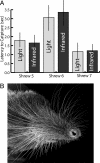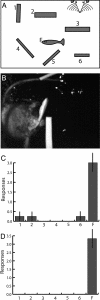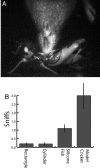Water shrews detect movement, shape, and smell to find prey underwater
- PMID: 18184804
- PMCID: PMC2206577
- DOI: 10.1073/pnas.0709534104
Water shrews detect movement, shape, and smell to find prey underwater
Abstract
American water shrews (Sorex palustris) are aggressive predators that feed on a variety of terrestrial and aquatic prey. They often forage at night, diving into streams and ponds in search of food. We investigated how shrews locate submerged prey using high-speed videography, infrared lighting, and stimuli designed to mimic prey. Shrews attacked brief water movements, indicating motion is an important cue used to detect active or escaping prey. They also bit, retrieved, and attempted to eat model fish made of silicone in preference to other silicone objects showing that tactile cues are important in the absence of movement. In addition, water shrews preferentially sniffed model prey fish and crickets underwater by exhaling and reinhaling air through the nostrils, suggesting olfaction plays an important role in aquatic foraging. The possibility of echolocation, sonar, or electroreception was investigated by testing for ultrasonic and audible calls above and below water and by presenting electric fields to foraging shrews. We found no evidence for these abilities. We conclude that water shrews detect motion, shape, and smell to find prey underwater. The short latency of attacks to water movements suggests shrews may use a flush-pursuit strategy to capture some prey.
Conflict of interest statement
The authors declare no conflict of interest.
Figures






References
-
- Conaway CH. Am Midland Nat. 1952;48:219–248.
-
- Lanpman BH. J Mamm. 1947;28:1.
-
- Nussbaum RA, Maser C. The Murrelet. 1969;50:23–24.
-
- Buchner CH. The Blue Jay. 1970;28:171–172.
-
- Sorenson MW. Am Nat. 1962;68:445–462.
Publication types
MeSH terms
Substances
LinkOut - more resources
Full Text Sources

